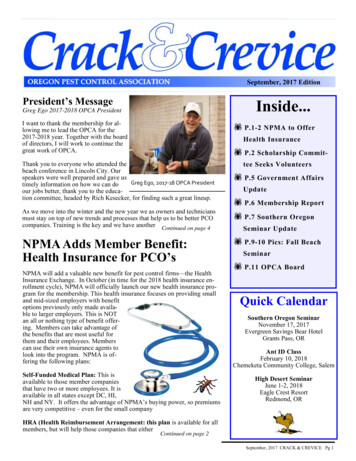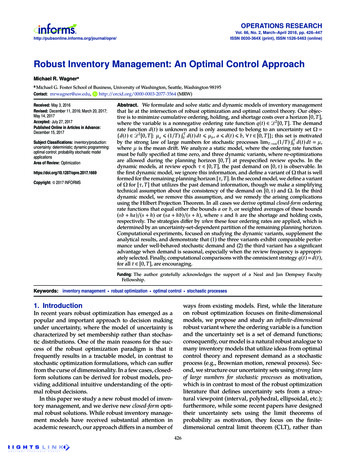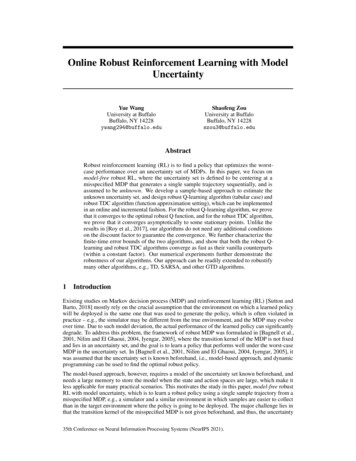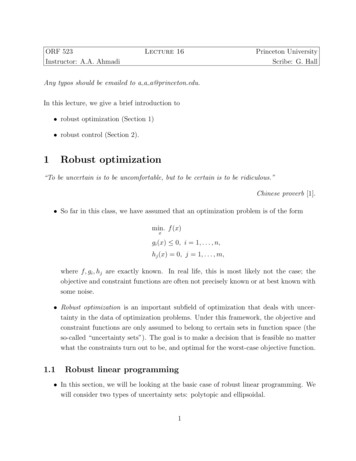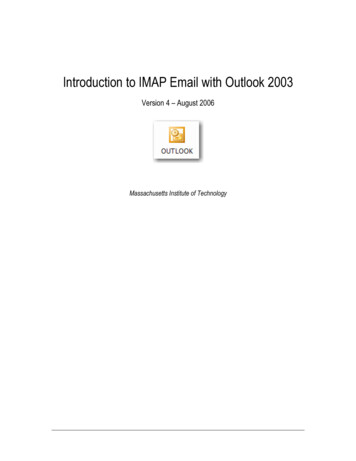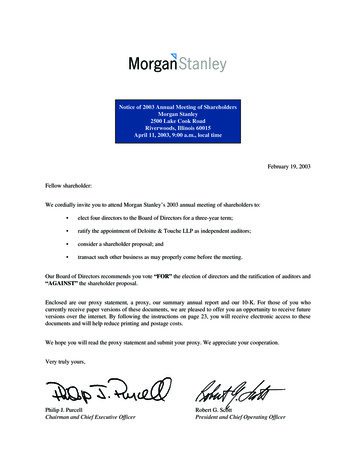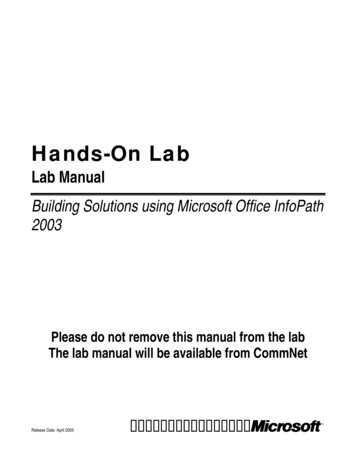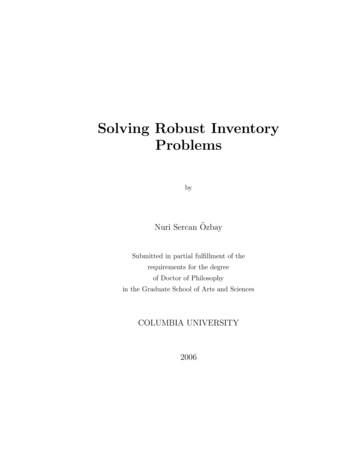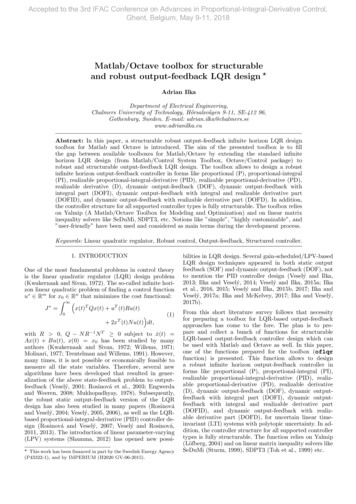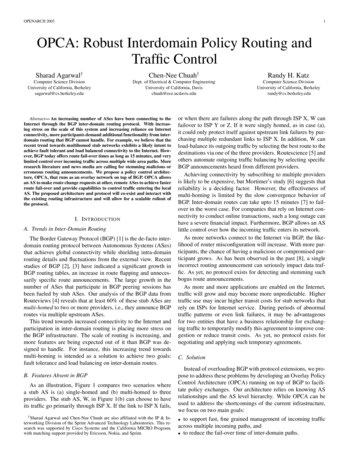
Transcription
OPENARCH 20031OPCA: Robust Interdomain Policy Routing andTraffic ControlSharad Agarwal†Chen-Nee Chuah†Randy H. KatzComputer Science DivisionUniversity of California, Berkeleysagarwal@cs.berkeley.eduDept. of Electrical & Computer EngineeringUniversity of California, Davischuah@ece.ucdavis.eduComputer Science DivisionUniversity of California, Berkeleyrandy@cs.berkeley.eduAbstract— An increasing number of ASes have been connecting to theInternet through the BGP inter-domain routing protocol. With increasing stress on the scale of this system and increasing reliance on Internetconnectivity, more participants demand additional functionality from interdomain routing that BGP cannot handle. For example, we believe that therecent trend towards multihomed stub networks exhibits a likely intent toachieve fault tolerant and load balanced connectivity to the Internet. However, BGP today offers route fail-over times as long as 15 minutes, and verylimited control over incoming traffic across multiple wide area paths. Moreresearch literature and news media are calling for stemming malicious orerroneous routing announcements. We propose a policy control architecture, OPCA, that runs as an overlay network on top of BGP. OPCA allowsan AS to make route change requests at other, remote ASes to achieve fasterroute fail-over and provide capabilities to control traffic entering the localAS. The proposed architecture and protocol will co-exist and interact withthe existing routing infrastructure and will allow for a scalable rollout ofthe protocol.I. I NTRODUCTIONA. Trends in Inter-Domain RoutingThe Border Gateway Protocol (BGP) [1] is the de-facto interdomain routing protocol between Autonomous Systems (ASes)that achieves global connectivity while shielding intra-domainrouting details and fluctuations from the external view. Recentstudies of BGP [2], [3] have indicated a significant growth inBGP routing tables, an increase in route flapping and unnecessarily specific route announcements. The large growth in thenumber of ASes that participate in BGP peering sessions hasbeen fueled by stub ASes. Our analysis of the BGP data fromRouteviews [4] reveals that at least 60% of these stub ASes aremulti-homed to two or more providers, i.e., they announce BGProutes via multiple upstream ASes.This trend towards increased connectivity to the Internet andparticipation in inter-domain routing is placing more stress onthe BGP infrastructure. The scale of routing is increasing, andmore features are being expected out of it than BGP was designed to handle. For instance, this increasing trend towardsmulti-homing is intended as a solution to achieve two goals:fault tolerance and load balancing on inter-domain routes.B. Features Absent in BGPAs an illustration, Figure 1 compares two scenarios wherea stub AS is (a) single-homed and (b) multi-homed to threeproviders. The stub AS, W, in Figure 1(b) can choose to haveits traffic go primarily through ISP X. If the link to ISP X fails,† Sharad Agarwal and Chen-Nee Chuah are also affiliated with the IP & Interworking Division of the Sprint Advanced Technology Laboratories. This research was supported by Cisco Systems and the California MICRO Program,with matching support provided by Ericsson, Nokia, and Sprint.or when there are failures along the path through ISP X, W canfailover to ISP Y or Z. If it were singly homed, as in case (a),it could only protect itself against upstream link failures by purchasing multiple redundant links to ISP X. In addition, W canload-balance its outgoing traffic by selecting the best route to thedestinations via one of the three providers. Routescience [5] andothers automate outgoing traffic balancing by selecting specificBGP announcements heard from different providers.Achieving connectivity by subscribing to multiple providersis likely to be expensive, but Mortimer’s study [6] suggests thatreliability is a deciding factor. However, the effectiveness ofmulti-homing is limited by the slow convergence behavior ofBGP. Inter-domain routes can take upto 15 minutes [7] to failover in the worst case. For companies that rely on Internet connectivity to conduct online transactions, such a long outage canhave a severe financial impact. Furthermore, BGP allows an ASlittle control over how the incoming traffic enters its network.As more networks connect to the Internet via BGP, the likelihood of router misconfiguration will increase. With more participants, the chance of having a malicious or compromised participant grows. As has been observed in the past [8], a singleincorrect routing announcement can seriously impact data traffic. As yet, no protocol exists for detecting and stemming suchbogus route announcements.As more and more applications are enabled on the Internet,traffic will grow and may become more unpredictable. Highertraffic use may incur higher transit costs for stub networks thatrely on ISPs for Internet service. During periods of abnormaltraffic patterns or even link failures, it may be advantageousfor two entities that have a business relationship for exchanging traffic to temporarily modify this agreement to improve congestion or reduce transit costs. As yet, no protocol exists fornegotiating and applying such temporary agreements.C. SolutionInstead of overloading BGP with protocol extensions, we propose to address these problems by developing an Overlay PolicyControl Architecture (OPCA) running on top of BGP to facilitate policy exchanges. Our architecture relies on knowing ASrelationships and the AS level hierarchy. While OPCA can beused to address the shortcomings of the current infrastructure,we focus on two main goals:to support fast, fine grained management of incoming trafficacross multiple incoming paths, and to reduce the fail-over time of inter-domain paths.
OPENARCH 20032Together, these goals serve to improve routing and traffic in thecurrent inter-domain routing structure, and allow it to scale better to the growing number of multi-homed ASes.OPCA consists of a set of intelligent Policy Agents (PAs) thatcan be incrementally deployed in all the participating AS domains. The PAs are responsible for processing external policyannouncements or route-change requests while adhering to local AS policies, and enforcing necessary changes to local BGProuters. These PAs communicate with one another via a newOverlay Policy Protocol (OPP). Such an overlay architecture allows ASes to negotiate the selection of inter-domain paths forincoming traffic with remote ASes, leading to more predictableload-balancing performance. In addition, an AS can requestrouting changes to other ASes to expedite fail-over. Our architecture does not require any modifications to the BGP protocolor to existing BGP routers.We will review related work in the next section. Section IIIdescribes the design of our architecture. In Section IV, we explain the rationale behind our design of OPCA. We follow thiswith a description of the applications of our architecture in Section V. We end with some deployment and scaling issues inSection VI and conclusions in Section VII.InternetInternetZXYXWW(a)(b)Fig. 1. (a) Company W with ISP X. (b) Company W with ISP’s X, Y and ZII. R ELATED W ORKHuston [9] suggests ways to address the problems of load balancing and route fail-over. There are two main approaches: (a)extending the current BGP protocol/implementations or (b) usealternate routing through overlay networks or replace BGP witha new interdomain routing protocol.Various BGP-based solutions have proposed to limit the advertisement scope of route announcements [10], [11], [12]. Forexample, BGP can be modified to allow bundling of routes or tospecify aggregation scopes. These proposals may limit the illeffects of multi-homing but do not solve the issues of fast failover and inbound load balancing that we are concerned with.Pei [13] proposes modifications to BGP to reduce convergencetime by identifying which withdrawals are due to actual failuresand filtering out announcements of invalid or conflicting pathsduring the transient periods. He employs a new community attribute to convey routing policy information over the traditionalBGP session. However, it does not address the issue of widearea traffic balancing. These schemes require a new versionof BGP to be deployed or many BGP routers to be reconfigured. This is difficult to accomplish given the widespread use ofBGP. Mortier [14] proposes a new route attribute that expressesa price for carrying traffic on the advertised route that one neighbor charges another. While this scheme adds another interestingattribute that can be used in route selection, it does not addressthe goals of our work in reducing route failover times and managing incoming traffic.All the afore-mentioned approaches rely on “in-band” signaling, i.e., they embed and distribute policy information in BGProuting messages. In this paper, we explore an orthogonal approach by introducing “out-of-band” signaling through OPCAto permit more flexibility and control of the policy distributionsand negotiations between AS domains. This results in more predictable performance for inbound traffic engineering. In fact,OPCA could potentially leverage these other BGP modificationsto obtain accurate connectivity information in a more efficientmanner, and based on this, make better policy decisions.In the early days of BGP, Estrin [15] proposed a centralizedrouting arbiter that collects all routing entries, centrally computes the “best” routes, and re-distributes the final routing entries. We believe that such an architecture is not deployed inthe Internet today due to its complexity and scalability issues.Alternative routing architectures have been proposed, such asRON [16], Nimrod [17], and BANANAS [18]. RON is an overlay network that uses active probing and global link state ina fully meshed network to customize routing between overlaynodes. RON is designed for applications with a small number ofparticipating nodes and cannot scale to the number of ASes thatexist today. Nimrod [17] was proposed in 1996 as an alternative inter-domain routing architecture. It would distribute linkstate information and support three forms of routing: MPLSlike flow routing, BGP-like hop by hop routing and data packetspecified routing. BANANAS [18] also distributes link state information and allows a sender to specify the full path for eachpacket. Although sender specified routing can help achieve loadbalancing and fault tolerance, packets will no longer go throughthe fast path in routers (such as Cisco Express Forwarding) andwill require more processing and hence delay. Nimrod and BANANAS also introduce the difficulty of timely link-state propagation which has not yet been addressed. These solutions propose to change the underlying routing protocol itself to routetraffic either on optimal or source-dictated paths. Our approachreuses the existing BGP routing protocol and builds an overlaylayer to achieve explicit control over policy distributions andload balancing.Frameworks and protocols for distributing policies within adomain that are based on MPLS, DiffServ or IntServ have beenproposed, e.g., COPS and Bandwidth Broker [19], [20], [21],[22]. MPLS Fast-Reroute maintains backup paths and switching entries for every link computed from link state informationflooded through the local network. In our solution, we focuson the inter-domain case and do not rely on the widespread deployment of DiffServ or MPLS, but instead rely on the alreadywidespread deployment of BGP.
OPENARCH 20033AS ZMIPDE-BGPPAPADirectoryOther ASdomains/networksin the InternetRMAPAS XPAEBGPE-BGPMIPAE-BGPsessionsAS YE-BGP speakerPDAS WFig. 2. Overlay Policy Control ArchitectureIII. OVERLAY P OLICY C ONTROL A RCHITECTURE (OPCA)A. OverviewThe Overlay Policy Control Architecture (OPCA) is designedto support fault-tolerant and efficient wide-area routing. Ourapproach leverages intra- and inter-AS measurement and monitoring systems that are commonly deployed in ASes to obtainsimple data on traffic load changes and network performance.As shown in Figure 2, OPCA consists of five components: Policy Agents (PAs), Policy Databases (PDs), Measurement Infrastructures (MIs), the PA directory and the AS Topology and Relationship Mapper (RMAP). Policy Agents (PAs) are intelligentproxies that reside in each AS domain that agrees to participatein the overlay policy distribution network. Most Internet Service Providers (ISPs) today have deployed a measurement infrastructure to monitor the performance of their network. Theyalso maintain a database of service level agreements (SLAs) andpeering arrangements. We assume that OPCA can reuse any ofsuch existing PDs and MIs within an AS domain. The PA directory and RMAP are new query-services introduced by OPCA.The next section describes each of these components in detail.We have completed the design of the PA protocol and the RMAPcomponent. We will reuse existing MIs and use the already deployed DNS for the PA directory. We are currently implementing the PA and PD and designing the evaluation methodology.B. Components of OPCAB.1 Policy Agent (PA)Intelligent Policy Agent (PAs) are introduced in each AS domain that employs OPCA to form an overlay policy distribution network. The PAs are responsible for processing externalpolicy announcements, processing local AS policies, and enforcing these policies at border routers participating in externalBGP sessions. This implies that PAs should have administrative control over the E-BGP speakers within their respective ASdomains. The E-BGPs are dynamically (re)configured to reflectpolicy changes, and continue to perform route selection basedon these policies. However, some form of synchronization maybe needed with PAs to prevent simultaneous conflicting changesfrom network operators. A centralized or distributed PA directory is needed to allow distant PAs (PAs belonging to differentASes) to communicate with each other. Each PA should be accessible at an IP address and port that can be reached from distant ASes.A routing policy will be influenced by traffic measurementsbetween the local AS and one or more distant ASes that areimportant, such as application level customers. To impose achange on the routing between these sites, a local PA will haveto negotiate with the remote PA, and possibly other intermediate policy agents. Contacting the appropriate intermediate PAswill be important, since conflicting routing and filtering policiesin other ASes along the route can severely impact the routingchange. Having an understanding of the relationships betweenASes along prospective routes [23] will be important to ensurethe effectiveness of protocol.The protocol that the PAs use to communicate with one another is the new overlay policy protocol (OPP). The design ofPAs and the OPP protocol is subject to certain constraints: The PAs should communicate with BGP speakers via conventional means, and should not require any modifications to therouters. This is important for the acceptability and deploymentof this protocol. The PAs should detect and identify policy conflicts at runtime, and avoid potential BGP oscillations or divergence. OPP should co-exist with the widely deployed IGP/EGP today such as BGP, IBGP, IS-IS or OSPF. The use of OPP should not increase BGP route flapping andthe number of routing table entries. The correctness and effectiveness of OPCA should not relyon every AS employing PAs. We strive to support incrementaldeployment, i.e., early adopters of the new PAs should not be ata disadvantage compared to those continuing to use only BGP,even though the utility of the new system may increase as moreASes subscribe to OPCA.B.2 Policy Database (PD)The policy database is a local repository of information thatwill help the local PA decide how to change routing for its domain. The PD should provide the following data: Ordered list of remote ASes containing the local domain’smain customers. This list identifies the target ASes that the PAshould focus its load balancing efforts at. This list can easilybe formed by examining the logs of the service provided by thelocal domain [24]. List of local application servers. The PA needs to know whichset of IP addresses serve content or any other service to the remote customers. The majority of traffic will likely be destinedfor or originate from these local servers. The PA will be concerned with the load balancing and fail-over of routes to theseaddresses. Pricing constraints and SLAs. The PA will try to balance traffic across multiple ISP links evenly weighted by actual link capacity. However, the local domain may prefer to weight trafficby pricing structures imposed by the SLAs it is operating under.If this is the case, the PA will need to be informed about these
OPENARCH 2003price constraints.B.3 Measurement Infrastructure (MI)Most ISPs and customer bases already employ some form of ameasurement infrastructure (MI). Some may use it to verify Service Level Agreement (SLA) specifications with a third party, ormay use it to manage their network. In our architecture, we assume that such an infrastructure already exists in each domainemploying OPCA. The MI helps the PA keep track of the effectsof the PAs alterations to routes and decide when such an alteration is necessary. The MI should provide the following data: E-BGP link characteristics. The PA needs data on each of thelinks connecting the local AS to the Internet. This data shouldinclude actual link capacity and current bandwidth load. Thisallows the PA to decide which links are underutilized and toverify the effect of policy changes that it imposes. PA controltraffic will also go over these links. Simple SNMP statistics oreven periodic polls of the Cisco IOS interface byte counters willsuffice. Customer-server traffic characterization.The MI shouldalso provide data outlining characteristics of traffic (such astotal bandwidth, average latency) that each main customersends/receives to/from each local server. This helps the PA understand the current traffic distribution and how to best redistribute this load. Tools such as Cisco Netflow should be able toprovide such data.B.4 PA DirectoryThe PA directory is a means by which a local domain’s PAcan locate the address for a distant AS’s PA. This is necessarybecause some ASes may not have PAs, since we do not rely onimmediate wide scale deployment of OPCA, and those that dohave PAs can place them anywhere inside their network. Thedesign of the directory is not a goal of our work. The systemcan use one or multiple directories, which may or may not becoherent with each other. From the architecture’s point of view,there is logically one PA directory. A simple solution such asusing the already deployed DNS can be used. The PA directory’sfully qualified domain name is known to all PAs and PAs needonly make DNS queries to locate other PAs.B.5 AS Topology & Relationship Mapper (RMAP)The RMAP is a repository of the inter-AS relationships andInternet hierarchy. These relationships determine how routingand traffic flows on the Internet as governed by route exportrules. Export rules dictate that when sending routes to a customer AS, a provider has to send it all the routes it knows of.When sending routes to a provider or peer, an AS does notsend other peer or provider routes. In the RMAP, we deducethese relationships from multiple BGP routing tables by applying heuristics. Our heuristic begins by ranking the ASes basedon their distance in the AS paths from the AS where we collect each routing table. We then infer whether an AS-AS linkrepresents a peer-peer or a provider-customer relationship basedon the relative ranks of each AS pair that shares a link. Using pruning, greedy ordering and weak cuts designed to exposethe different business classes of Internet service providers, we4also infer the hierarchical structure of the AS topology that exists today. Details of our algorithm can be found in our priorwork [23].The RMAP is an essential component to OPCA. The architecture is indifferent to whether there is only one global RMAP or ifmultiple RMAPs exist for different ASes. The only requirementis that the RMAP have access to enough diverse BGP routingtable dumps as to be mostly accurate. We will revisit this issuein Section IV. PAs need the RMAP to find the likely path a distant AS uses to reach it and the intermediate AS relationshipsthat determine how routes propagate to the distant AS. This alsohelps to determine if a policy request will conflict with a distantAS’s local routing policy.C. Overlay Policy ProtocolC.1 Message PropagationOPP carries inter-PA messages from the source PA to the destination PA over UDP by rendezvousing first through the PA directory. Therefore, PA control messages do not have to throughevery PA in the intermediate ASes the same way as BGP announcements propagate from one BGP speaker to another, because the originating PA has the burden of determining the appropriate destination PA to contact directly. The advantages ofthis approach are eliminate intermediate PA processing keep convergence time of PA messages lower than that ofBGP messages give originating PA more control give more privacy to originating PAsC.2 Connections and SessionsWe choose unreliable, connectionless UDP over reliable,connection-based TCP because the reverse route may be unavailable during link failure. Consider the case in Figure 5where X uses the path X F C A to reach A. Supposethe C A link fails and A wants X to failover to the F E B A path. A’s PA has to contact F’s PA to make the routingchange. A already has an alternate path to F via B and can useit to send the message to F. However, until F receives the PA request and implements it, it will not have a working return path toA to send a response. This is why OPP uses UDP messages because TCP connections cannot be setup in some circumstances.In some conceivable scenarios of multiple concurrent outages,even multi-hop PA communication may be required. Duringlink failure, a PA may not be able to receive replies from thePD. If there are DNS servers available via backup links, thenthis is not an issue. We are exploring how a PA can proactivelycache the locations of various other PAs that it would need tocontact during link failure.C.3 OPP MessagesSince all the OPP messages will be connectionless UDP messages, they will have to identify the sending PA’s IP address,UDP port and AS number. In Figure I, we list the messagesthat OPP will support for fast failover and incoming traffic loadbalancing. The error codes will include such errors as invalidrequest, conflict with peering policy, unknown address range
OPENARCH 20035TABLE IOPP M ESSAGESMessagePA locate(AS)e.g., PA locate(25)PA locate reply(AS,ipaddr,port,timeout)e.g., PA locate reply(25,169.229.62.121,8919,6000)PA route(prefix)e.g., PA route(128.32.0.0/16)PA route reply(prefix,AS Path)e.g., PA route reply(128.32.0.0/16,11423 25)PA block(prefix,AS1,AS2)e.g., PA block(128.32.0.0/16,25,11423)PA block reply(error code,prefix,AS1,AS2)e.g., PA block reply(0,128.32.0.0/16,25,11423)PA select(prefix,X,Y)e.g., PA select(128.32.0.0/16,7018,50)PA select reply(error code,prefix,X,Y)PA select reply(1,128.32.0.0/16,7018,50)DescriptionMessage from a PA to the PA directory requesting the address of a PA in a remote ASReply from the PA directory, containing the IP address and port of the requested PAand the number of seconds after which the reply is invalidRequest from a PA to another PA for the best route chosen for a particular prefixReply from a PA giving the AS path chosen for a network prefixRequest from a PA to another PA to block all announcements for a particular prefix(or all addresses if null) that contain “AS1 AS2” anywhere in the AS pathReply from a PA giving the status of a previous block requestRequest from a PA to another PA to select the announcement for a particular prefixfrom AS-X when re-announcing to AS-YReply from a PA giving the status of a previous select requestand address range ownership verification failed. Each PA willhave the option of using publicly available address allocationregistries to verify that a request to change routing for an address range came from the AS that owns it. Further, we expecta deployed system to use a public key authentication system toprovide additional protection against malicious use. The PA directory will have a public key that is known widely. All repliesfrom the PA directory will have to be signed by its private keyand will contain the public key of the PA who’s address is beingqueried. All PAs that receive requests will verify that they weresigned by the private key belonging to the originating PA.We are continuing to define all the error codes and additionalmessages that will be needed for augmenting peering relationships, detecting bogus routes and blocking bogus routes.reachability in BGP have little control over how those advertisements propagate and are applied. This influences how trafficreaches the advertising domain. The end AS has better aggregate knowledge on the characteristics of the traffic entering itsnetwork but can do little to change routing at distant ASes toaffect the traffic flow.The alternate structure shown in Figure 3(b) has been proposed in the research literature as we described in Section II.While in this scenario an end AS may be able to influence whichroutes are used to reach it, there are many issues that need to beresolved, such as scalability of link state information, computational complexity, full disclosure of routing policies and loss ofroute selection control for each AS.PA PAASIV. OPCA D ESIGN R ATIONALEIn this section, we discuss the design rationale behind OPCA.We begin by examining why using a separate control path fromBGP helps us achieve our goals. We also discuss the use ofmultiple BGP views to improve the accuracy of OPCA.A. Separating Policy and RoutingPA PAASPAASPAASPAASFig. 4. Our rbiterRouteAnnouncementAS(a)ASAS(b)Fig. 3. (a) Current Routing Scenario (b) Route Arbiter ScenarioThe key design constraint of the current inter-domain routing system as shown in Figure 3(a) is that domains advertisingInstead we propose to separate routing and policy as shown inFigure 4. We continue to use the BGP infrastructure to disseminate and select routes, thereby avoiding issues such as the linkstate propagation, route selection control, computational complexity and full disclosure of routing policies. We augment thesystem with an overlay protocol to explicitly request routing policy changes between ASes directly, where the two ASes can negotiate policy conflicts and exchange more routing and trafficinformation.In theory, we could propose our own BGP community attribute and distribute policy control information along with BGProutes. However, the advertiser will not know a priori which remote BGP speakers adhere to the new community specification,which makes the results of such approaches less predictable.
OPENARCH 2003Furthermore, the system would suffer from the same BGP convergence times.The routing policy conveyed by BGP is essentially “controlsignaling” that attempts to influence the route selection processat the remote router. The basic routing functionality only requires exchange of connectivity information (e.g., AS Path andNexthop). Therefore the key premise behind OPCA is that separating the policy (the control part) from routing (basic connectivity information) will provide much more flexibility in controlling inter-domain paths, which can potentially lead to betterperformance, new services, and prevention of bogus routes.The specific advantages of this approach include: Reduced response time for failure recoveryWhen there is a failure or a change in routing, BGP today cantake up to 15 minutes to converge to a new route. By the timetraffic is forwarded correctly on the new path, network conditions could be vastly different from what prompted the changein the first place. During transient fail-over periods, traffic canget caught in routing loops or become black-holed, resulting inincreased packet loss or delay jitter. This can adversely impactthe perceived quality of networked applications. OPCA helps tohasten failure recovery by determining the distant AS that seesboth (or more) possible paths. It allows the local AS to contactthis distant AS and switch the route instead of waiting for normal BGP failure recovery. Hence, the response time of routechanges in the data plane can be greatly reduced. Enhanced traffic engineering performanceTwo major difficulties in inter-domain traffic engineering are ASPath asymmetry and localized routing decisions. For example,when an AS-X supplies hints of how AS-Y can reach it via a setof AS paths, it is up to AS-Y to decide which path to choose, andhence could diminish the intended load balancing results. Theoutgoing path from AS-X to AS-Y can be different from the return path, and may experience different performance in termsof delay and losses. OPCA allows ASes to directly negotiaterouting policies with one another and determine the best possible inter-domain path. Using the same example, once AS-X andAS-Y reach a consent, OPCA will configure their BGP routersto select the agreed-upon BGP route. The intermediate ASescan also be updated if necessary. Augmenting peering relationshipsTwo ASes are said to have a peering relationship if they agree toexchange traffic directly without exchanging money. However,this also implies certain routing constraints that do not allowtransit traffic to flow through a peering link. Through a separatelayer of policy distribution and negotiation, OPCA can allowtwo ASes to allow temporary passage of certain transit traffic inexchange for money to reduce congestion or mitigate networkpartitions. Better support for detecting and handling misconfigured
OPENARCH 2003 3 PA Directory PA MI PD PA PA MI PD AS W AS X AS Y AS Z RMAP Other AS domains/networks in the Internet E-BGP EBGP E-BGP E-BGP speaker E-BGP sessions Fig. 2. Overlay Policy Control Architecture III. OVERLAY POLICY CONTROL ARCHITECTURE (OPCA) A. Overview The Overlay Policy Control Architecture (OPCA) is designed
